Juncus acutus: Red Data Book of Armenia

EN B 1 ab(i,ii,iii) + 2 ab(i,ii,iii)
Category. Endangered species. The extent of occurrence and the area of occupancy of are less than 500 km2. The species grows in the area of intensive agricultural activity. It was not included in the first edition of the Red Data Book of Armenia. It is not included in the Annexes of CITES and that of the Bern Convention.
Description. Perennial, tussock forming marsh herb. Stems 30–120 cm. Basal leaves cylindrical, 1–2 mm in diameter, blades well developed, firm, acuminate; sheaths reddish–chestnut–colored. Inflorescence of 4–6 branches, sessile or on peduncles 4–5 cm long. Fruit a green capsule 5–6 cm long, ovoid, without rostellum. Seeds elongate or elliptic, with whitish caudiform processus.
Distribution. In Armenia it is distributed only in Yerevan (Ararat, Yuva, Shahumyan, Yerakh mountain range) floristic region. EOO is 250 km2, AOO is 16 km2, the number of locations is 3. The general area of distribution includes East, West and South Transcaucasia, Talish, Europe, Mediterranea, Anatolia, Iran.
Ecological, biological and phytocoenological peculiarities. Grows in lower mountain belt, at the altitudes of 800–1000 (1200) meters above sea level, in salt marshes, near mineral springs and travertins, on moist saline soils. Flowering from June to July, fruiting from August to September.
Limiting factors. Restricted extent of occurrence and area of occupancy, active influence of economic activity (irrigation, drainage of marshes, grazing, desalinization of soils, vegetation burning), climate change.
Conservation actions. In 2008 "Salt marshes" near Ararat town were marked as nature monument, but at present no conservation is being carried out. Necessary: monitoring of the population state.
Suggestions
 The Ministry of Environment sent a letter international partners to draw their attention to the real danger of environmental disasters as a result of Azerbaijan's large-scale aggression towards the territory of Armenia
The Ministry of Environment sent a letter international partners to draw their attention to the real danger of environmental disasters as a result of Azerbaijan's large-scale aggression towards the territory of Armenia
 Vicia pisiformis: Red Data Book of Armenia
Vicia pisiformis: Red Data Book of Armenia
 Vavilovia formosa: Red Data Book of Armenia
Vavilovia formosa: Red Data Book of Armenia
 Trigonella capitata: Red Data Book of Armenia
Trigonella capitata: Red Data Book of Armenia
 Trigonella astroides: Red Data Book of Armenia
Trigonella astroides: Red Data Book of Armenia












